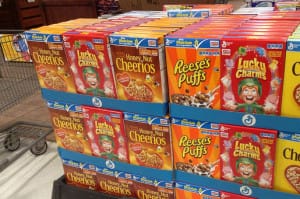The Washington Post
by Drew Harwell
 |
Breakfast behemoth General Mills, maker of Trix, Reese’s Puffs and Lucky Charms, said Monday it plans to remove artificial colors and flavors from its cereals by 2017, becoming the latest food giant to swap out the additives in response to changing American tastes.
Instead of dyes like Red No. 40 and Yellow No. 6, Trix’s crunchy rainbow corn balls will be colored by turmeric, a yellow spice in curries and mustard, and juice concentrates of blueberries, radishes and strawberries. Artificial vanilla will be replaced by the real stuff in the peanut-butter-loaded Reese’s Puffs.
“People eat with their eyes, and so … the trick is, how can we maintain an appealing look, just not using the artificial colors?” said Jim Murphy, the president of General Mills’s cereal division. “People don’t want colors with numbers in their food anymore.”
The flavors won’t change, General Mills senior manager Lauren Pradhan said, and there will be “minimal to no changes in nutrition.” Still, some breakfast bowls will undergo a bit of a makeover: The new Trix, for instance, will kill off its fluorescent blue and green puffs, which chemists found hard to color without artificial dyes.
The move puts General Mills in the same food-conglomerate camp as Taco Bell, McDonald’s and Kraft, which over the last year have loudly removed mostly-harmless additives in hopes of making their foods look fresher or more natural.
But food experts said General Mills’s changes are merely a marketing ploy, intended to make their cereals appear to be a healthier addition to breakfast bowls.
“These companies are desperate to keep parents buying these really unhealthy foods … and now they can trumpet ‘no artificial dyes’ as if that makes it a health food,” said Michele Simon, a public-health attorney and president of Eat Drink Politics, a food-industry consulting firm.
“These kid-oriented cereals are still extremely processed, have virtually no nutritional value and are fortified with vitamins because the real nutrients have been stripped in processing,” Simon added. “If they really wanted to be healthier, they should stop bombarding children with messages to eat candy in a box.”
About 60 percent of General Mills’s cereals — like Cinnamon Toast Crunch, Cheerios, Kix and Total — are already free of artificial colors, but the rest of the company’s cereal aisle will drop the fake stuff by 2017. Prices won’t change, the company said, when the new Trix and Reese’s Puffs hit shelves this winter.
Kate Gallagher, a company cereal developer, said some of the fake-ingredient removals have proven “more challenging than others.” In Trix, “red is one where we haven’t been able to get that same vibrant color, but we’re still able to get a nice red that pops in the cereal bowl and is still a fun eating experience.”
The most herculean change, the company says, will come from removing fake colors and flavors from marshmallow-loaded cereals like Lucky Charms and Count Chocula because the spongy sugar balls are harder to reflavor than flakes of grain. “We are committed,” Gallagher added, “to finding a way to keep the magically delicious taste.”
The Minneapolis-based General Mills is one of the world’s biggest food giants and sold about $18 billion of Betty Crocker, Fiber One, Haagen-Dazs, Pillsbury, Old El Paso and other brands worldwide in fiscal year 2014.
But the cereal industry has struggled as foods like Greek yogurt and snack bars have taken over the breakfast table. Cereal is still America’s favorite morning food, but U.S. sales have crumbled 5 percent over the last five years, to about $11 billion, data from market researcher Euromonitor show.
The company, Pradhan said, began working on this “one step in our larger cereal journey” three years ago, as more buyers showed a growing preference for natural flavors and simpler ingredients. A General Mills survey conducted by Nielsen found about 49 percent of households are trying to avoid artificial flavors and colors, the company said.
“We want to make sure cereal is relevant for our families today … so we’ll be on breakfast tables for the next hundred years,” Pradhan said. “If these ingredients are stopping them from enjoying cereal in the morning, we want to remove them.”
Artificial dyes are, of course, not health food, either. And General Mills has taken some steps to better their food, including reducing sugar in cereals like Cookie Crisp and Lucky Charms, from about 12 grams to 10 grams per serving. But advocates say the cereal remains worryingly sweet, a problem that simply taking out artificial additives won’t fix.
“What they’re looking to do is trim around the edges, doing whatever they can do that doesn’t change their business model but looks like they’re making a change,” said Simon, the public-health lawyer. That’s because real health-aimed improvements “like not marketing them to children or to parents who probably shouldn’t be feeding their kids candy for breakfast … would take too serious a toll on sales.”

